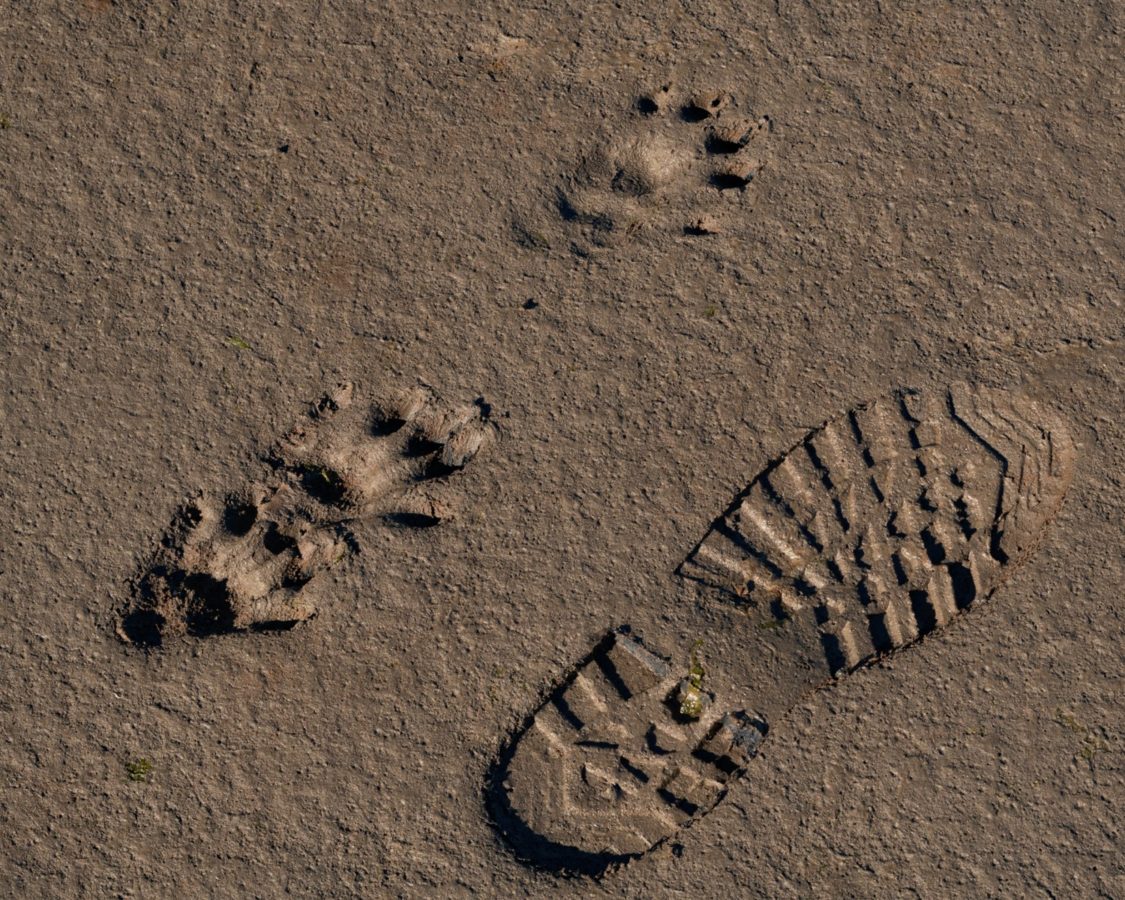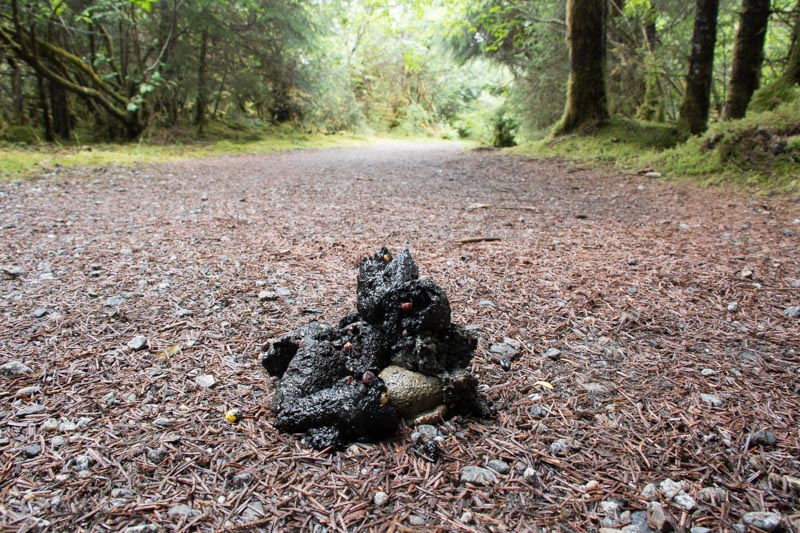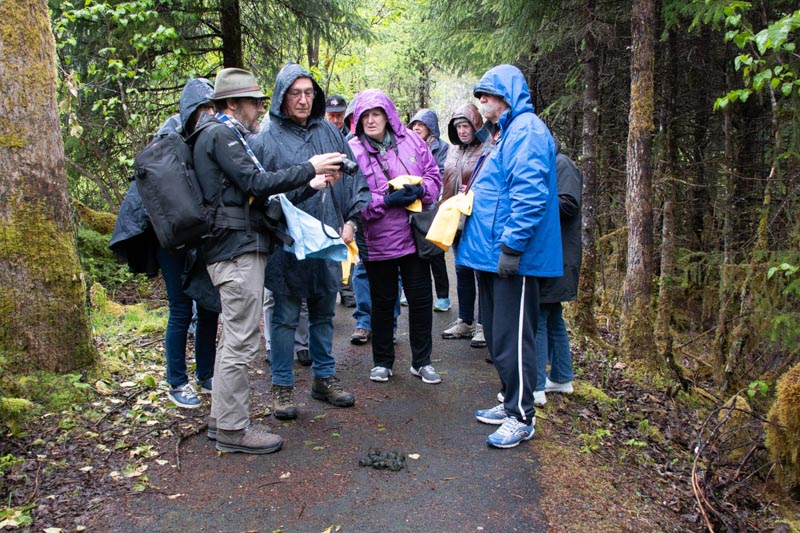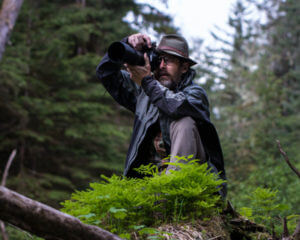Juneau Wildlife: Learning from what’s left behind

Spring in the shadow of Mendenhall Glacier means a symphony of new sights, sounds and smells on the trails. Migratory birds are arriving, looking for mates and filling the air with song. Lupine, saxifrage, and skunk cabbage that have been dormant for the long, dark winter, are putting on new leaf and flower to regale hikers. And bears are descending from their hibernation dens on the side of Thunder Mountain in search of spring grasses, roots, and flowers, to begin their annual fattening season. In short, the Tongass is coming to life!
While song, leaf and flower cannot be missed by even the most casual observer, evidence of bears is a little less obvious, but with just a little sleuthing it too, is easily revealed. In the pebbles along lakeshore, the silt of the riverbank and mud on the trail, tracks and scat seem to magically appear—large tracks and piles from sows, coupled with tiny tracks and piles from young cubs exploring the world outside their dens for the first time.
We compare paw prints to our own, take pictures of them next to outstretched hand, and boot track. We poke and prod scat with sticks to find evidence of ground cone, or skunk cabbage. For our shore excursion guests, seeing these tracks and scat add elements of excitement, and mystery. And for this guide a fresh pile of bear poop sometimes causes a spontaneous rap!
It starts with an “S” and it ends in a “T”
It comes out of you, and it comes out of me
I know what you’re thinking; you can call it that,
But lets be scientific, and call it “Scat!”
Standing over a fresh pile of bear scat one morning last summer, I rapped the scat rap until a woman in the group interrupted me. In the middle of the third line, her eyes widened as she pointed over my shoulder and exclaimed, “I think it’s right behind you, Jim!” I turned around to watch, forty feet away, a small black bear crossing the trail and disappearing into the woods.
Bears aren’t the only animals that leave their mark along the trail, though. Snowshoe hares, beaver, deer, and mink, as well as ravens, herons, and ducks frequently leave tracks, and it is not uncommon to find porcupine droppings here and there on our hikes.
Late in the season, last year, I saw what appeared to be a pile of dog poop on the trail. “Watch your step,” I said over my shoulder. As we neared the pile, I saw that it was tapered on one end, and full of dark hair. “Gather ‘round,” I said, kneeling beside the pile. A dozen guests formed a circle around me, some also kneeling. The scat was dry and odorless, so I pulled a few hairs from one of the clods. “Anybody recognize this? Feel it. It’s soft!”

On brave gentleman, to the consternation of his girlfriend, took the hairs from me, raised them to his nose, then rolled them between his fingers. “Beaver?”
“Yep. What do you think eats beaver around here?”
“Bear?” asked one man.
“Not with scat like this,” I responded.
“Wolf!” a woman proclaimed.
“You got it!”
Nobody else wanted to touch the hair, but now nearly everybody took a closer look at the fur-filled scat. Farther down the trail, as we approached the lakeshore and views of Mendenhall Glacier, my fellow guide Caitlyn appeared around the bend. Pulling me aside, she excitedly whispered in my ear, “I think there’s wolf tracks along the shore!” I didn’t say anything to my guests for the same reason Caitlyn whispered. Should the tracks prove to be those of a golden retriever, we don’t want to build hopes only to dash them. Given our recent discovery, though, my hopes were quite high.

Sure enough, along the shore of Mendenhall Lake were a pair of huge canine tracks. At nearly six inches long, with wide spread toes and long nails, these were no doubt Canis lupus! Seeing a wolf track did something the cool glacial breeze could not that morning: goose bumps appeared on my forearms, and the hair on the back of my neck stood at attention. With scat and fresh tracks, we half expected a wolf to appear any minute. We could feel its presence.
Speaking of a wolf’s howl, Aldo Leopold wrote that, “Those unable to decipher the meaning know nevertheless that is it there, for it is felt in all wolf country, and distinguishes that country from all other land. It tingles in the spine of all who hear wolves by night, or who scan their tracks by day.”
For a moment, nobody said anything. We stood in a circle around the tracks, feeling the idea that a wolf might be nearby. Eventually, photos were taken, then our attention turned to the glacier, and my usual conversation about the important connections between slow-moving rivers of ice and humpback whales, between eroding mountains and phytoplankton. But all the talk of glaciers could not calm the tingling we all felt knowing that somewhere nearby there was a wild wolf.
I ended our tour by reciting more of Leopold’s essay Thinking Like a Mountain—an essay that, thirty years ago, changed the way I thought about wild lands, and my connection with them. In the essay, Leopold tells the story of the extirpation of wolves in the American west, and of the resulting damage to the landscape when deer become overpopulated. Leopold suggests that in our pursuit of “safety, prosperity, comfort, (and) long life,” we are also, inadvertently, striving after dullness, and that “too much safety seems to yield only danger in the long run.”
The tension apex predators provide an ecosystem is the ballast that keeps everything stable, but it is more than that. From the unfortunate beaver, to the Sitka deer, to you and me, living with apex predators heightens the senses, allowing—even forcing—us to fully experience the world around us. Simply knowing that we are sharing our immediate landscape with wolves—or bears, or big cats—even if all we ever see is tracks and scat, ensures that life will never be dull, and that is worth more than all the safety, prosperity, and comfort in the world.
It is spring at the Mendenhall Glacier. The snow has melted in the valley, skunk cabbage and purple mountain saxifrage are blooming in bog and on mountainside, and varied thrushes and pacific wrens are singing in the woods. And though there is little in this world that brings a bigger smile to my face than spring birds and blooms, these delights will never “tingle the spine” like knowledge of an unseen apex predator.
Today, I will walk a trail. Along the way I will smell the flowers, I will sit in silence and listen to the birds Hopefully, somewhere along the way, I will find a track, or a pile of scat, and when I do, I will feel a little tingle, and the flowers will smell a little sweeter, and the bird-songs will sound a little more poetic, as I will wonder who might be just out of sight picking up my scent on the breeze, listening to my footsteps on the path.
About the Author: Jim Pfitzer is about to begin his second season as a guide for Gastineau, and his second year as an an Alaskan. He was born and raised in Chattanooga, TN, but has moved all over the country pursuing wild places and even wilder experiences. When asked about himself, Jim says he would rather paddle a canoe than drive a car, and prefers watching birds to watching television. “That about sums me up,” he says.


